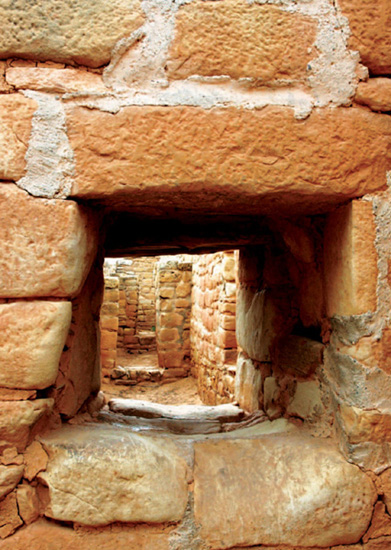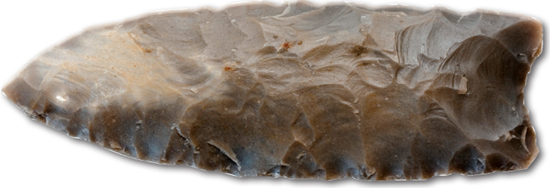

The first people to live in the Americas were the Indians, or Native Americans. Their settlements ranged across the Western Hemisphere and were built on many of the sites where modern cities now rise. Indian families and traders used paths now followed by roads and railroads. Indian farmers were the first in the world to domesticate corn (maize), beans, squash, potatoes, tomatoes, and many other food plants that help feed the peoples of the world today. These resources, along with others provided by hunting, gathering, and fishing, were used to support communities ranging from small villages to expansive cities with tens of thousands of residents.
The first Indians arrived during the last ice age, when thick ice sheets covered much of northern North America. As the ice sheets absorbed water, sea levels dropped and a land bridge emerged along the present-day Bering Strait. From about 30,000 to 12,000 years ago the land bridge connected northeastern Asia to what is now Alaska. Humans began to cross over from Asia at least 13,000 years ago and perhaps much earlier. When the ice sheets melted, the land bridge disappeared under the rising seas and the migration ended.

Early humans crossed from northeastern Asia to the Americas over a now-submerged land bridge across the Bering Strait. The locations of archaeological sites in the Americas suggest the migration routes followed by Paleo-Indians after the glaciers of the late Pleistocene Epoch melted.
The earliest peoples of the Americas are known as Paleo-Indians. They lived by hunting and gathering. As people began to settle down and expand their diets, they developed what are called Archaic cultures. In addition to foraging, Archaic peoples began to experiment with agriculture.
By about 2300 BC Indians in the Andes Mountains of South America had adopted a fully agricultural way of life. They began to settle in villages. Farming villages appeared by 2000 BC in Middle America (present-day Mexico and Central America) and somewhat later in Northern America (present-day United States and Canada). Over time these prehistoric farmers developed new kinds of societies. Advanced cultures arose in Middle and South America that rivaled the great civilizations of ancient Egypt, Mesopotamia, and China.
The very early people of the Americas were the Paleo-Indians. They shared some cultural traits with peoples of Asia, such as the use of fire and domesticated dogs. However, they do not seem to have used other Old World technologies such as grazing animals, domesticated plants, and the wheel.
Paleo-Indians shared the land with such large mammals as mammoths, mastodons, and giant bison. Archaeological sites of Paleo-Indians often include bones from these animals. This has sometimes led to the mistaken idea that these peoples only hunted big game. By the turn of the 21st century, however, excavations had shown that Paleo-Indians used both animal and wild plant foods, including fruit, tubers, and even seaweed.
Mastodons and woolly mammoths were hunted by some Paleo-Indians. These animals were similar in size to modern African elephants but, unlike the modern variety, they were adapted to Ice Age temperatures. Encyclopædia Britannica, Inc.
The best-known Paleo-Indian cultures of North America are Clovis and Folsom. The Clovis culture was the older of the two. Its people left behind one of the most distinctive Paleo-Indian artifact types—the Clovis point. These spear points are leaf-shaped and made of stone. They are also fluted, meaning that they have grooves on each flat side. The culture was named for an archaeological site near Clovis, N.M., where the first such point was found among mammoth bones in 1929. Scrapers (used to clean the hide) and other artifacts used to process meat have also been found at Clovis sites. The Clovis culture was long believed to have lasted from about 9500 to 9000 BC. However, early 21st-century research suggested it may have lasted a shorter time, from about 9050 to 8800 BC.

The Clovis spear point is a characteristic Paleo-Indian artifact. iStockphoto/Thinkstock
Folsom culture seems to have developed from Clovis culture. It is also known for its own distinctive spear point. Like Clovis points, Folsom points are leaf-shaped, but they are more carefully made and have much larger flutes. The first Folsom point was discovered in 1908 at a site near Folsom, N.M., along with the remains of a now-extinct form of giant bison. The Lindenmeier site, a Folsom campsite in northeastern Colorado, has yielded a variety of scrapers, gravers (used to engrave bone or wood), and bone tools. The Folsom culture is thought to have lasted from about 9000 to 8000 BC. Related Paleo-Indian cultures, such as Plano, continued to between 6000 and 4000 BC.
Discoveries of several sites in the late 20th century challenged the longstanding belief that Clovis people were the first Americans. Monte Verde, a site in Chile, dates to about 10,500 BC. It is the oldest confirmed site of human habitation in the Americas. A number of other sites may be as early or earlier than Monte Verde. In North America archaeologists have found evidence of pre-Clovis cultures at the Topper site in South Carolina, Cactus Hill in Virginia, and Schaefer and Hebior in Wisconsin.
The Archaic cultures developed from Paleo-Indian traditions. They arose in response to environmental changes. Beginning some 11,500 years ago temperatures rose dramatically worldwide. Large animals such as mammoths could not cope with the change and became extinct. Other animals, such as bison, survived by becoming smaller. At the same time new grasses, trees, and other plants developed.
As the environment changed, so did the Indians’ lifestyles. The most visible change was in their diet. Archaic peoples used a wider range of plant and animal foods than the Paleo-Indians had. They relied more upon smaller animals such as deer and elk. Archaic peoples caught more fish and collected more shellfish from rivers and lakes. They also gathered seeds, an addition to the larger plant foods of the Paleo-Indians, such as fruit and roots. People became somewhat more settled, tending to live in larger groups for at least part of the year. They also developed systems of trade. In the late Archaic people began to farm.

Bison weathered the escalating temperatures by leading up to the Archaic period becoming smaller. Ron Levine/The Image Bank/Getty Images
Archaic peoples adapted to their environments by inventing many new technologies. They introduced the spear-thrower, a short, hooked rod that enables a hunter to throw a dart accurately and with great force at a distant target. So-called bird stones may have been used as weights on the spear-thrower to increase the hunter’s throwing power. Large fluted points became less popular, replaced by smaller side-notched points more appropriate for hunting with darts. Woodworking tools developed by Archaic peoples included grooved stone axes and gouges made from ground and polished stone.
The spear-thrower was an innovation of the Archaic period. It consisted of a rod with a hook or projection at the rear end to hold the weapon in place until its release. The device gave the spear greater velocity and force. Encyclopædia Britannica, Inc.
The length of the Archaic period varied across the Americas. It lasted from approximately 8000 BC until at least 2000 BC in most of Northern America, from 7000 to 2000 BC in Middle America, and from 6000 to 2000 BC in South America. But in some places Archaic cultures persisted much longer. For instance, Indians in the Great Basin of the U.S. Southwest kept their foraging lifestyle well into the 1800s.